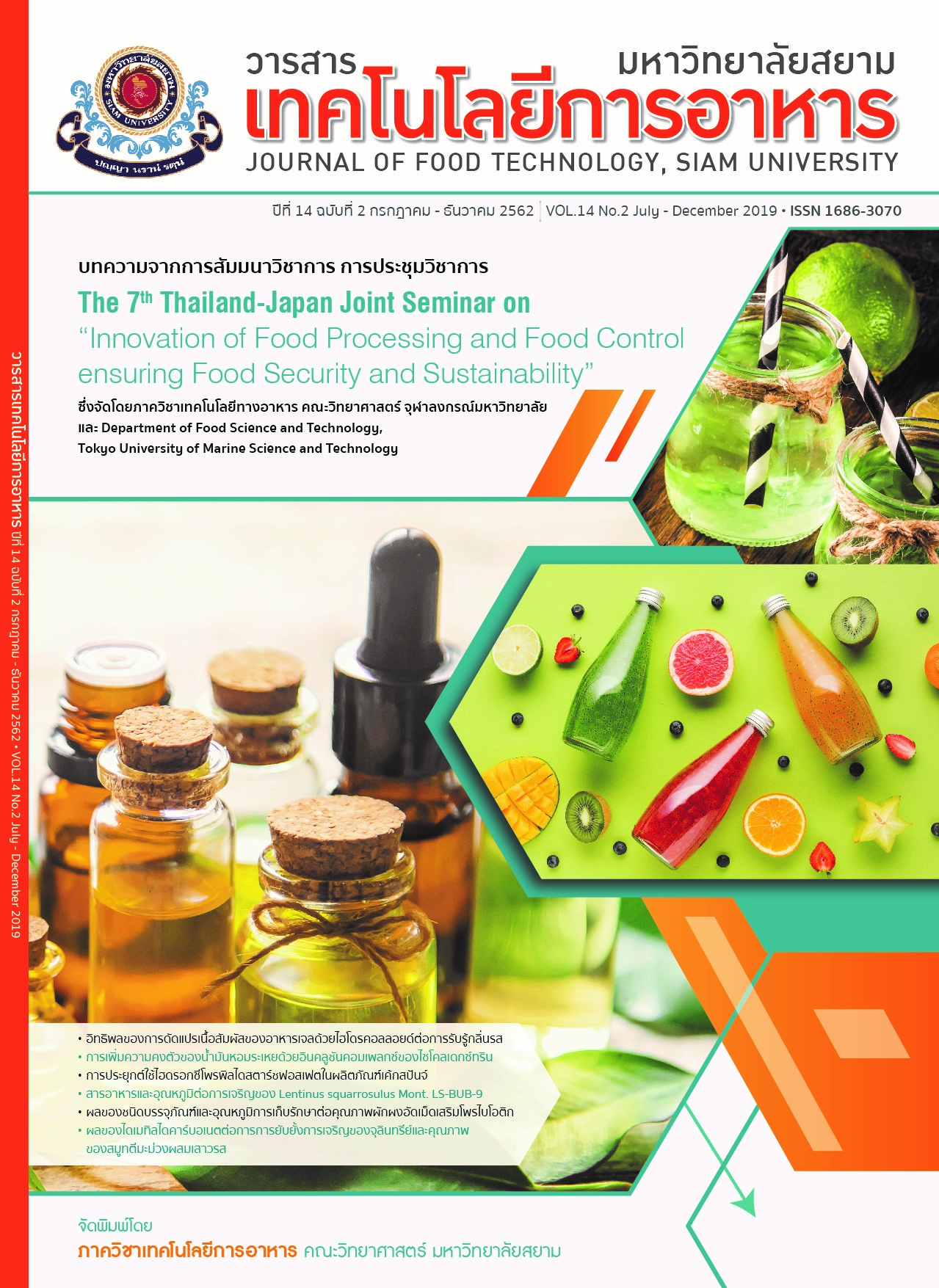การประยุกต์ใช้ไฮดรอกซีโพรพิลไดสตาร์ชฟอสเฟตในผลิตภัณฑ์เค้กสปันจ์
Main Article Content
บทคัดย่อ
งานวิจัยนี้มีวัตถุประสงค์เพื่อศึกษาผลของการทดแทนแป้งสาลีด้วยไฮดรอกซีโพรพิลไดสตาร์ชฟอสเฟต (HDP) ต่อสมบัติทางกายภาพและลักษณะทางประสาทสัมผัสของเค้ก สปันจ์ จากการทดลองพบว่า การทดแทนแป้งสาลีด้วย HDP ที่ร้อยละ 20-40 ทำให้ความถ่วงจำเพาะของส่วนผสมเหลว ปริมาตรจำเพาะ standing height และ volume index ของเค้กลดลงจากสูตรควบคุม (p≤0.05) เค้กสูตรทดแทนแป้งสาลีด้วย HDP ร้อยละ 40 มีค่า hardness และ gumminess ต่ำที่สุด (p≤0.05) เนื้อเค้กสูตรผสม HDP มีการกระจายตัวของโพรงอากาศไม่สม่ำเสมอ และมีจำนวนโพรงอากาศขนาดใหญ่เพิ่มขึ้น เค้กผสม HDP ทุกสูตรได้รับคะแนนความชอบด้านสี เนื้อสัมผัส รสชาติ และความชอบโดยรวมไม่แตกต่างจากสูตรควบคุม (p>0.05) แต่ได้รับคะแนนความชอบด้านลักษณะปรากฏต่ำกว่าสูตรควบคุม (p≤0.05) การทดแทนแป้งสาลีด้วย HDP ที่ร้อยละ 30 เป็นระดับสูงสุดที่ทำให้เค้กมีค่า hardness ไม่แตกต่างจากสูตรควบคุม (p>0.05) และมีคะแนนความชอบด้านลักษณะปรากฏในระดับชอบเล็กน้อยถึงชอบปานกลาง จึงเลือกสูตรดังกล่าวมาศึกษาการเปลี่ยนแปลงคุณภาพระหว่างการเก็บที่ 25 องศาเซลเซียส 7 วัน เทียบกับสูตรควบคุม พบว่า ค่า hardness gumminess chewiness และ aw ที่ผิวนอกของเค้กทั้งสองสูตรเพิ่มขึ้น แต่ aw ที่เนื้อในลดลงอย่างมาก (p≤0.05) ใน 2 วันแรก และเปลี่ยนแปลงเล็กน้อยหลังจากนั้น นอกจากนี้ยังพบว่า การทดแทนแป้งสาลีด้วย HDP ที่ร้อยละ 30 ช่วยชะลอการเพิ่มขึ้นของค่า hardness ระหว่างการเก็บรักษาได้
Article Details
บทความทุกบทความในวารสารเทคโนโลยีการอาหาร ทั้งในรูปแบบสิ่งพิมพ์ และในระบบออนไลน์ ถือเป็นลิขสิทธิ์ของมหาวิทยาลัยสยาม และได้รับการคุ้มครองตามกฎหมาย
เอกสารอ้างอิง
[2] Yang, X. and Foegeding, E. A. (2010). Effects of sucrose on egg white protein and whey protein isolate foams: Factors determining properties of wet and dry foams (cakes). Food Hydrocolloids. 24(2): 227-238.
[3] Poonnakasem, N. (2014). Effect of hydrocolloids and lipids on physicochemical properties and consumer acceptance of sponge cake. Ph.D. Dissertation, Department of Food Technology, Faculty of Science, Chulalongkorn University.
[4] Chaiya, B. and Pongsawatmanit, R. (2011). Quality of batter and sponge cake prepared from wheat-tapioca flour blends. Kasetsart Journal of Natural Science. 45(2): 305-313.
[5] Singh, J., Kaur, L. and McCarthy, O. J. (2007). Factors influencing the physico-chemical, morphological, thermal and rheological properties of some chemically modified starches for food applications—A review. Food Hydrocolloids. 21: 1-22.
[6] Tulyathan, V. (2006). Food Chemistry of Carbohydrate. Bangkok: Chulalongkorn University Press. (in Thai)
[7] Kim, C.S. and Walker, C.E. (1992). Interactions between starches, sugars, and emulsifiers in high-ratio cake model systems. Cereal Chemistry. 69(2): 206-212.
[8] Lee, C.C., Hoseney, R.C. and Varriano-Marston, E. (1982). Development of a laboratory-scale single-stage cake mix. Cereal Chemistry. 59(2): 389 - 392.
[9] Baker, B.A., Davis, E.A. and Gordon, J. (1990). The influence of sugar and emulsifier type during microwave and conventional heating of a lean formula cake batter. Cereal Chemistry. 67(3): 451-457.
[10] Pong, L., Johnson, J.M., Barbeau, W.E. and Stewart, D.L. (1991). Evaluation of alternative fat and sweetener systems in cupcakes. Cereal Chemistry. 68(5): 552-555.
[11] Cloke, J.D., Davis, E.A. and Gordon, J. (1984). Volume measurements calculated by several methods using cross-sectional tracings of cake. Cereal Chemistry. 61(4): 375-377.
[12] Lee, C.C., Johnson, L.A., Love, J.A. and Johnson, S. (1991). Effects of processing and usage level on performance of bovine plasma as an egg white substitute in cakes. Cereal Chemistry. 68(1): 100-104.
[13] AOAC. (1995). Official Methods of Analysis. Washington D.C.: Association of Official Analytical Chemists.
[14] Wilderjans, E., Luyts, A., Brijs, K. and Delcour, J.A. (2013). Ingredient functionality in batter type cake making. Trends in Food Science & Technology. 30(1): 6-15.
[15] Wilderjans, E., Luyts, A., Goesaert, H., Brijs, K. and Delcour, J.A. (2010). A model approach to starch and protein functionality in a pound cake system. Food Chemistry. 120(1): 44-51.
[16] Luyts, A., Wilderjans, E., Van Haesendonck, I., Brijs, K., Courtin, C.M. and Delcour, J.A. (2013). Relative importance of moisture migration and amylopectin retrogradation for pound cake crumb firming. Food Chemistry. 141(4): 3960-3966.


